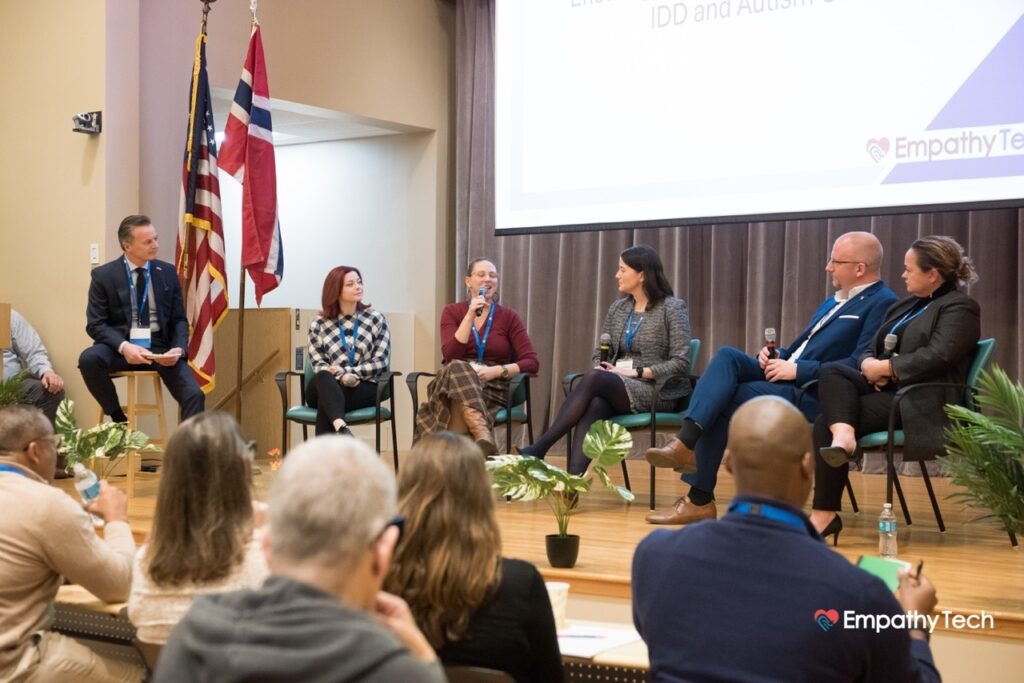Empathy, Technology, and Caregiving: Insights from the Empathy Tech Conference

Could technology, designed with empathy and informed by the experiences of older adults and their caregivers, help us to navigate the challenges of aging? At last month’s EmpathyTech Conference in Philadelphia, co-sponsored by NewCourtland and Pletly, the answer was a resounding yes. A dynamic panel of experts and innovators explored how empathy is shaping the future of technologies for older adults and their family caregivers.
Moderated by Gary Pezzano, President and CEO of Leading Age PA, the panel included:
- Jack Stoddard, chief executive officer of Patina Health, a primary care provider for older adults seeing patients in their homes and virtually in Philadelphia, PA, and Charlotte, NC areas.
- Kelly Johnston, co-founder and chief operating officer of Quarvis Health, a healthcare technology platform that provides voice-enabled medication and appointment reminders, among other tools.
- Ellen Andersen, chief executive officer of SensCom AS, which developed DignaCare, a wearable sensor that detects incontinence, alerting care staff to provide timely personal care;
- Anne Ollen, managing director of the TIAA Institute, a think tank that conducts research and education on financial services, pensions, and longevity for non-profits, universities, and their
- George Demiris, associate dean of research and innovation at the University of Pennsylvania’s School of Nursing, who designs, implements, and evaluates technologies to help older adults and their families age in place.
The panel offered valuable perspectives on how empathy and technology interact. “Technology with empathy is about creating solutions that respect and understand the core needs of both the individuals and those who support care,” Andersen said.
The Aging Landscape and the Need for Innovation
Pezzano set the stage by describing the changing landscape of informal care in the United States. He cited recent studies showing that nearly a quarter of Baby Boomers have no children, and more than a third are without grandchildren. Coupled with higher divorce rates and greater geographic distance between families, the trends portend a growing shortage of informal caregivers for an aging population.
The panelists highlighted how empathy-driven technology could bridge gaps in caregiving. Dr. Demiris noted, “With the proliferation of new technologies, especially with artificial intelligence, we have a lot of new powerful tools that can allow us to do many more things at home that we couldn’t have imagined before. But empathy is key in driving the design of these solutions if we want them to be ultimately used and be effective for the end users, who are older adults and the family members.” Johnston highlighted the need to overcome the stigma surrounding at-home safety products, pointing out how negative associations with phrases like “I’ve fallen, and I can’t get up!” have hindered the acceptance of life-saving technologies. The key is creating tools that prioritize dignity while addressing real safety concerns. Andersen spotlighted the importance of integrating new products into existing healthcare workflows and systems, like electronic health records, despite the inevitable resistance that often comes with change. Ollen emphasized the need to spread awareness of these innovations so that technology reaches those who need it most, and she highlighted colleges and universities as potential partners in these efforts.
Navigating Funding and Testing Roadblocks
When asked about the most critical needs for innovation in aging and caregiving, the panelists were unanimous: more funding. Demiris elaborated on the need for faster innovation cycles, advocating for testing new technologies within the communities they are designed to serve. This, he said, would help generate the data needed for reimbursement and broader adoption. On attracting investor attention, Stoddard shared his insight: successful innovation requires finding individuals who believe in your vision for the future. “Then you have to generate data and results…if you can get someone to give you a shot and get some proof points under your belt, then you go from selling vision to selling outcomes,” Stoddard added.
Glimmers of Hope: The Power of Empathy and Collaboration
Despite the daunting challenges, the panelists remained optimistic. Key glimmers of hope included cross-sector collaboration, which is breaking down silos between academia and industry, and between the healthcare and financial industries. As more stakeholders recognize caregivers’ importance in the innovation process, there is a broader push to ensure that caregiving is not just a peripheral concern but a central focus of technological development. Another cause for optimism is the influx of young, passionate talent entering the innovation space, coupled with the promise of artificial intelligence, which could dramatically improve efficiency and speed up the deployment of much-needed technologies.
Conclusion: The Role of Empathy in Shaping the Future of Care
The discussions at the Empathy Tech Conference reinforced a powerful message: innovation in aging and caregiving must be guided by empathy. As the panelists discussed, it’s not enough to simply create new technologies; those technologies must be designed with a deep understanding of the unique challenges and emotions that older adults and their caregivers face daily. From breaking down stigmas to ensuring accessibility and funding, every step in the innovation process should be rooted in a commitment to improving lives. As we look ahead, the continued integration of empathy into aging and caregiving technologies will be key to fostering a future where older adults and their caregivers are genuinely supported, empowered, and heard.


